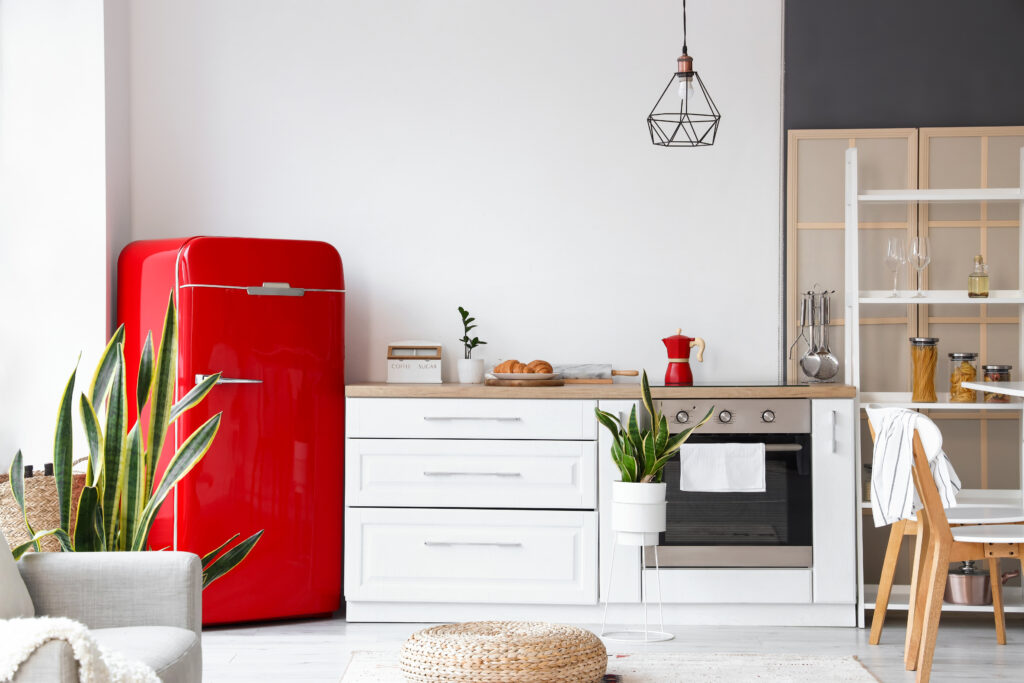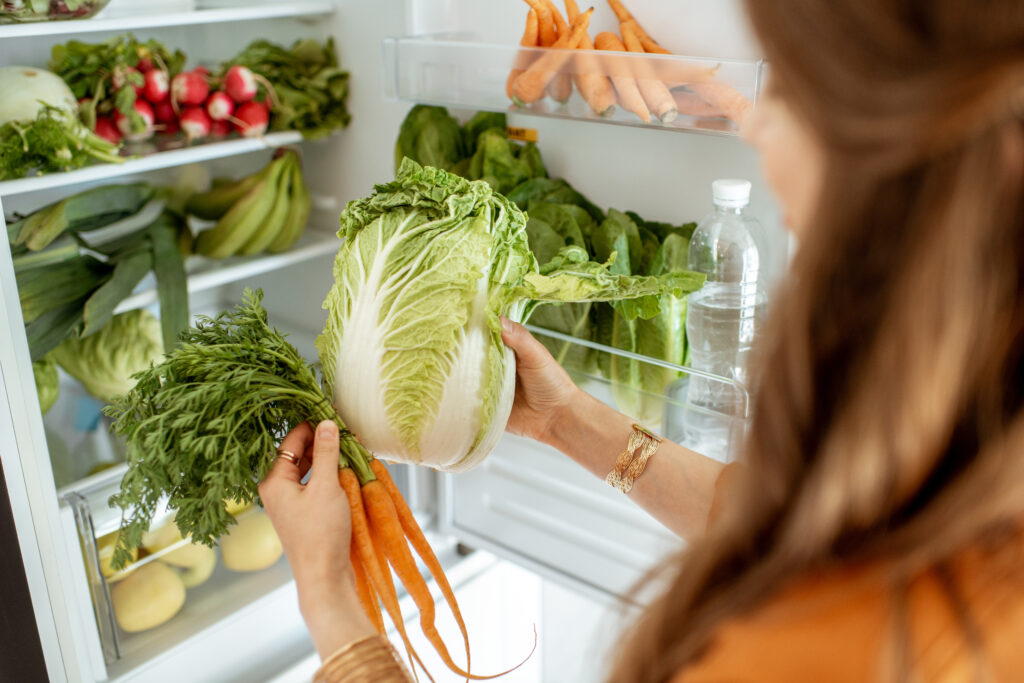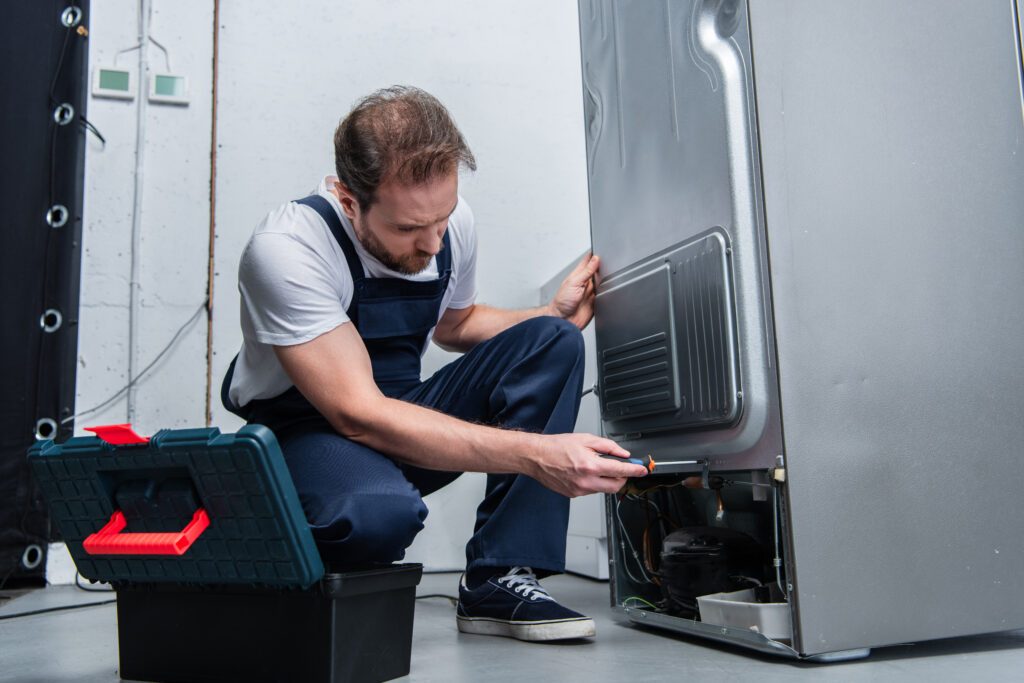Some of the links on this page are affiliate links, which means that Buzzy Kitchen earns commission from purchases made – at absolutely no extra cost to you. Thank you so much for supporting Buzzy Kitchen!
Have you ever opened your fridge, expecting to find your vegetables chilled to perfection but instead found them starring in their own icy kingdom? I’ve been there myself, on more than one occasion.
I think it’s time for us to take a deep dive into why you have a problem with food freezing in the fridge.
Food Freezing in the Fridge: 19 Reasons
From frosty mysteries to chilly solutions, join us on this frosty adventure as we explore the reasons behind a fridge that thinks it’s a freezer. Here are the top 18 reasons why you have food freezing in the fridge:
1: Temperature Set Too Low
If you have accidentally set the temperature or setting of the fridge too low, it will get too cold and result in freezing food. I have personally experienced this and had to dispose of at least three punnets of mushrooms because they froze over. It turns out, I’d accidentally bumped the temperature dial, which made the fridge colder. This is the first thing you should check if your fridge isn’t running as expected.
The temperature in your fridge should be between 0°C and 5°C.

If you have a dial with numbers rather than temperatures, the lowest number (0/1) is the warmest setting, with the highest number (5/7) being the coldest.
You should opt for between 2 and 4 on the dial.
If you have more food in the fridge, set it higher: 3 or 4. If the fridge is virtually empty, lower the dial: 2 or 3.
The more food/drink/condiments/etc. you have in the fridge, the colder the temperature. A fridge with very little inside needs a lower temperature/lower dial number.
2: Blocked Vents
Refrigerator vents are important because they allow the cool air to enter and keep the food inside cold. It’s important to know where these vents are, because blocking them could cause a whole host of problems, one of which is food freezing in the fridge.
When the vents are blocked, the fridge thinks the temperature is warmer than it actually is, so it throws out more cool air to compensate. This will lead to super cold spots inside the appliance, in which food freezes instead of simply staying cold.
The opposite can also occur; the fridge can think it is too cold, in turn warming itself up.
3: Power Cuts
Power cuts will, obviously, lead to a fridge or fridge-freezer being turned off for some time. Short-term power cuts are fine; the fridge and freezer will stay as cold as they should be, for however long you leave the doors closed. If you open the doors, the cool air will escape, and the temperature inside will rise.

When the power turns back on, it’s not uncommon for a fridge to overcompensate for the outage, excessively cooling the appliance. In turn, cold spots in the fridge will freeze.
4: High Humidity
Have you ever put hot food in the fridge before it’s properly cooled down? Every time you do that, you increase the humidity inside the appliance, just a little bit. This has a detrimental effect in several ways.
Firstly, the fridge will need to work much harder to keep the internal temperature to what you have said.
Secondly, ice crystals will start to grow on food and other items. After some time, your food can become partially or completely frozen.
Thirdly, your energy usage and cost will increase.
Always wait for hot food or other hot items to cool down to room temperature before putting them in the fridge.
5: Malfunctioning Thermostat
If the thermostat isn’t working correctly in your fridge, you’ll likely find that the temperature is everything except the one you want it to be. When the thermostat is broken, the fridge will think the temperature inside is hotter or colder than it actually is, so it’ll work harder to compensate.
You can replace the thermostat on a fridge or fridge-freezer. The parts themselves are usually priced between £5 and £70 depending on make, model, age, and other factors. If you’re hiring someone to do the repairs, you’ll also need to take the cost of labour into consideration.
Is your fridge still under a manufacturers or retailers guarantee? If yes, get in touch with them to arrange repairs or a replacement.
You should also check with your home insurance policy. Depending on what the issue is, you might not end up out of pocket.
6: Fridge Position
Putting a fridge in a very cold room, such as the garage in winter, can lead to the fridge becoming cooler both inside and outside. In turn, this can lead to cold spots and frost buildup, which can freeze refrigerated food.

Placing the refrigerator away from direct sunlight, heat sources (such as stoves or radiators), and drafts helps maintain a stable and consistent internal temperature. This is crucial for food safety and preserving the freshness of your groceries.
Fridges work more efficiently when they don’t have to combat external heat sources. If it is placed in a warm/hot area or near appliances that generate heat, it will need to work harder to maintain the correct temperature. This leads to increased energy consumption and higher bills. And we all hate that, right?
7: Placement of Contents
Refrigerators have different temperature zones, with colder temperatures near the back and bottom. Placing perishable items like dairy, meat, and seafood in these colder zones helps keep them at safe temperatures and slows down bacterial growth.

Placing items in a way that allows for proper airflow ensures even cooling throughout the fridge, and proper organization helps minimize the length of time the fridge door is open, which conserves energy and reduces the workload on the cooling system.
8: Overloading
Packing your fridge to the absolute brim is not a great idea. It can block vents, cause air blockages, and cause hot or cold air pockets. If you consistently fill your fridge up to the brim, it’s probably time to invest in a larger appliance; otherwise, your fridge will only be working at part-capacity instead of full capacity.
Proper air circulation is essential for a refrigerator’s cooling system to work efficiently. If you overcrowd the fridge with items, you can block the flow of air, making it harder for the appliance to maintain consistent temperatures.

And that’s not all.
When a refrigerator is packed too tightly, it needs to work harder to maintain its internal temperature. The higher workload can lead to higher energy consumption and energy bills. A well-organized fridge allows for more even distribution of cool air. If items are crammed together, some areas might become colder than necessary, potentially freezing items that shouldn’t be frozen.
9: Food Packaging
Although it’s not normal for a fridge to freeze food, you might find that some food items get too cold even when the appliance is set to the right temperature and working as it should. Oftentimes, this is down to poor packaging, or poorly insulated packaging.
Food items with high moisture content are more susceptible to freezing. Packaging that doesn’t provide a sufficient barrier against cold air and moisture can contribute to freezing. Thin or inadequate packaging materials might not offer enough protection from temperature fluctuations.
10: Damaged Door Seal
Having a damaged door seal, also known as a gasket, on your fridge is like having a permanently open window that lets the cooled air out. The cold temperatures will leak out, leaving the fridge warmer than it should be. In turn, the fridge will pump out too much cool air to try and compensate, resulting in super cold patches that freeze food.

The primary function of a refrigerator door seal is to create an airtight barrier between the inside of the fridge and the surrounding environment. If the seal is damaged, cold air can escape from the fridge, and warm air can seep in. This can cause temperature fluctuations inside the refrigerator, leading to inconsistent cooling and potential spoilage of perishable items.
If warm air enters the fridge compartment due to a damaged seal, it can lead to excessive ice formation on the walls and around the door. This not only reduces storage space but also hampers the appliance’s efficiency.
11: Poor Insulation
A poorly insulated fridge is not going to work as efficiently as a well-insulated one, just like a poorly insulated house will be colder and more expensive to heat than a well-insulated one.
It is possible to replace the insulation in your fridge, but it usually involves removing the back panel, then removing the old insulation before then replacing it with the new stuff.
Improving or adding to the insulation in your fridge can help it to run better and more efficiently but doing it yourself isn’t recommended if you’re not 100% sure what you’re doing.
12: Malfunctioning Temperature Sensor
When the sensor in your fridge breaks, the appliance literally has no clue what’s going on with the temperature inside. The sensor is meant to communicate the exact temperature, so cool air can be added if necessary, or the blowing of cool air is stopped. If it malfunctions, it will communicate the wrong temperature, which results in the appliance being too warm or too cold.
13: Faulty Defrost Timer
The defrost cycle is an essential part of a refrigerator’s operation, as it prevents excessive frost buildup on the cooling coils, which can reduce the appliance’s efficiency and cooling performance over time. If the defrost cycle is faulty or not working properly, it can lead to various problems, such as frost buildup, an overworking compressor, water leaks, inconsistent cooling, a too-warm freezer (if it’s a fridge-freezer), and costly energy bills.
14: Malfunctioning Defrost Heater
Alongside the defrost timer, the defrost heater is another vital part of the cooling-and-heating process in a fridge. The defrost timer is a component that controls when the defrost cycle occurs in the refrigerator’s cooling system.
A faulty defrost heater can lead to issues like frost buildup, inconsistent cooling, and other problems.
15: Leaking Compressor
In some cases, albeit rare, the compressor can become broken and cause the fridge to start freezing food. Wear and tear can happen over time, alongside physical damage, and these can contribute to refrigerant leaks from the closed loop system.

This can lead to a whole host of issues, such as uneven cooling and frost accumulation in certain areas of the refrigerator, food spoilage and wastage, higher energy usage, increased energy bills, and more.
16: Faulty or Damaged Control Board
The control board in a refrigerator, also known as the main control board or motherboard, plays a crucial role in regulating and managing various functions of the appliance. If the control board breaks or malfunctions, it can have several negative impacts on the refrigerator’s performance and functionality. These include:
- inaccurate temperature readings
- improper defrosting
- blocked airflow
- accumulation of frost and ice
- random temperature changes
- unexpected power cycling
- warning lights
- error codes
- unresponsive controls
- fan and compressor issues
- component damage
- internal communication issues
- and more!
17: Design Flaws
It is entirely plausible that some fridges and other electrical kitchen appliances and gadgets will have design flaws, especially in the current day and age. Nothing really works as it’s supposed to, right? Especially printers. Don’t even get me started on printers.
If your fridge has poor temperature distribution, it’ll have temperature fluctuations, or a temperature that you don’t want – such as too hot or too cold. I’d definitely recommend having a chat with the retailer or manufacturer if you’re having issues with a brand-new fridge or fridge-freezer.
18: Broken Fridge
Other components can also malfunction in/on a fridge, especially if the appliance if particularly old. In many cases, pieces can be replaced, or the appliance can be repaired, but not always. You’ll likely have a hard time finding spare or replacement parts for older models, discontinued models, and no-longer-in-business brands.

19: Leaving the Door Open
If you leave the door of your fridge open for long periods of time, accidental or otherwise, you are letting the cool air out. The fridge will then add more cool air to compensate and bring things back to the right temperature.
Repeatedly leaving the door open can leave the fridge essentially confused. It will try to reach the temperature you have set, but is unable to. Over time, this can cause problems with the thermostat, control board, and more.

No more eating cake, hiding in the fridge, in the middle of the night for me, then!
Food Freezing in Fridge: Conclusion
Unless you’re familiar with the inside workings of a refrigerator, there’s a pretty good chance that you’re not going to be able to determine what the issue is by sight alone.
Thankfully, you do have options when it comes to replacing or repairing a broken fridge. Alongside checking your home and contents insurance, warranty, and/or guarantee, you could also consider hiring a repair person or company. I had a quick look around for fridge repairs in my local area, and quotes were in the region of £80 to £100 for same day/next day repairs, labour, parts, and a 6-month guarantee.
In fact, I think I might go into this subject in a little more detail. Keep your eyes peeled, folks…
You might also like:
- An Introduction to Air Fryers
- 101 Gifts For Cheese Lovers 2022 Edition
- What Does a Velvetiser Do?
- 21 Top Rated Air Fryers Under £50
